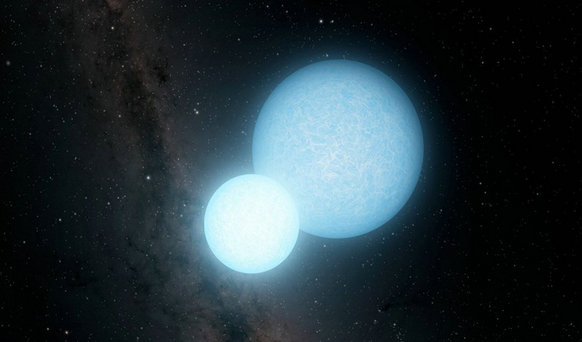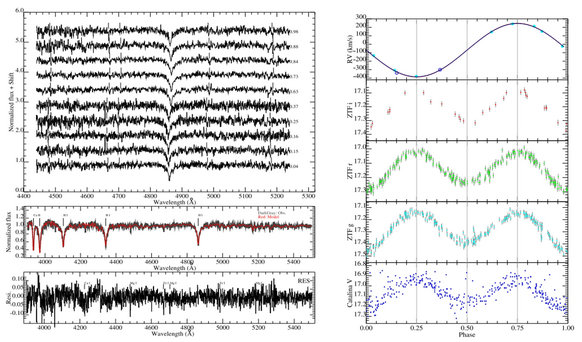A binary system containing an extremely low-mass (ELM) white dwarf (WD) progenitor and a compact invisible companion, was discovered by Chinese astronomers from the National Astronomical Observatories of Chinese Academy of Sciences (NAOC), using spectroscopic data from LAMOST and P200/DBSP, and multi-band photometric data from Catalina and Zwicky Transient Facility. The mass of the visible star, a pre-ELM WD, is about 0.09 solar masses, lower than the theoretical limit of its species, and may challenge the current formation theory of the ELM WD.
The study has been published in Astronomical Journal on February 21.

Figure 1. ELM WD schematic diagram (Credit: Caltech / IPAC)
Most stars in the Universe will end their lives as white dwarfs after their nuclear fuel were burned out. Most of the white dwarfs are carbon-oxygen white dwarfs (CO WD), which means they are mostly composed of Carbon and Oxygen. They have masses of 0.5-1.4 solar masses.
When the mass is greater than 1.4 solar masses, the electron degeneracy pressure at the core cannot resist the gravity and the white dwarf will continue to collapse into a neutron star. White dwarfs between 0.33 and 0.5 solar masses can have cores dominated by either CO or Helium (He). White dwarfs with even lower masses, known as ELM WDs, are composed of degenerate He.
It is believed that these ELM WDs cannot form via the single star evolution channel, since the formation of such single low mass He WDs requires a progenitor star with a correspondingly very low initial mass and an extremely long evolution time, a time even longer than the current age of our Universe. Therefore, it is generally accepted that ELMs are formed within interacting binary systems.
In particular, it is proposed that the even lower mass fraction of ELMs (below 0.18 solar masses) loses most of its initial mass via a stable Roche Lobe overflow channel.
To successfully form an ELM, the onset of the mass transfer should be at the right time. If the mass transfer starts too early, the donor will evolve into a low-mass main sequence star, similar to the secondary in the Cataclysmic Variable.
On the other hand, if it starts too late, the core of the donor will be massive enough to evolve to the next stage by helium flash. Thus, there is a theoretical lower mass limit of the ELM-WD in such a restricted mass transfer process, which is about 0.14-0.16 solar masses.
"The special pre-ELM-WD looks like a normal F-type dwarf star orbiting an invisible component every 5.27 hours. It may have just completed its mass-transfer phase and is moving slowly towards the white dwarf cooling path. Its constant luminosity implies that its energy is supplied by a tiny burning hydrogen shell outside the degenerate He core. However, its dynamical mass is only about 0.09 solar masses, below the lower limit of theoretical predictions, which is indeed puzzling," said Dr. YUAN Hailong, first author of the study.
The mass of the system is estimated based on multi-band time-domain photometric and spectroscopic data and Gaia parallax. After taking into account all error budgets, the estimated mass is still significantly low. The team has tested several theoretical models, none of which could fit the results properly. This discovery raises a question about the current ELM formation mechanism that is still awaiting an answer.
The invisible compact component could have a mass of ~1.0M☉, and is more likely to be a WD, but a neutron star cannot be ruled out at present.
The ELM binary systems with compact companions may be continuous gravitational wave sources and are among the most revealing objects in the gravitational wave detection project.
As an important progress of the LAMOST compact object search project, the discovery proves the ability of LAMOST to study the ELMs. With more time-domain plates coming in during LAMOST's second regular five-year survey, more interesting compact binary systems are expected to be discovered.

Figure 2. The time domain resolution spectra, RV curve and multi-band light curves of J2240. (Credit: YUAN Hailong)






